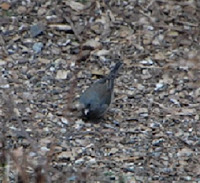I don't get questions from my readers, but if I did they might look like this:
Dear Birder:
My neighbor has spent the last week having some very tall, very old trees cut down in her backyard and one in her front yard. Why would someone want to take down so many trees at once?
Perplexed
Dear Perplexed:
There could be many reasons why. Perhaps these were ash trees infected with the emerald ash borer, the reason I had a dead tree removed earlier this month. Perhaps the homeowner was afraid a strong wind or snow storm would bring one or more of them down on the house. Perhaps the owner is putting in a swimming pool or a deluxe playset for the kids and the trees were in the way. Or the owner got tired of picking up fallen branches.
It is not YOUR backyard so ignore the devastation. Put up more feeders to attract the birds the cutting down has displaced.
Dear Birder:
My feeder has two sides but when certain birds come they fight each other over one side. Why can't they share the feeder?
Wondering
Dear Wondering:
Far be it from me to decipher the thinking of birds. You do not say what type(s) of bird. There are some that are more territorial than others. White-breasted nuthatches, for instance. They are small but feisty and if another one or even a larger bird of a different type tries to get to the feeder the first will chase off the second. I have found hummingbirds to be the same way when I hang a nectar feeder.
 |
| Nuthatch on the feeder about to chase off a titmouse. (Margo D. Beller) |
Cardinals will spend more time chasing each other away than eating, unless it is a pair. A pair, during mating season, will sit on either side of my house-shaped feeder but another male or another female approaching will get chased off. So I can't tell you why your birds fight. Maybe hanging more feeders farther apart will help.
Dear Birder:
This year I have a lot of juncos coming to my seed feeders. Last year I had very few. Why do I get a lot some year and none at other times?
Watching
Dear Watching:
I wonder about that myself. I think a lot depends on the wind and weather during the migration period. Maybe when the juncos were heading south from the breeding grounds to your yard (the males stay farther north than the females; in my yard I see only male juncos) the winds were favorable and there was a lot of food (such as from your feeders) to encourage juncos to stick around.
 |
| Junco (Margo D. Beller) |
I have been seeing fewer cardinals and white-throated sparrows and more house finches, at least those few times during the workday when I can look outside. But as we used to say in Brooklyn, wait til next year.
Dear Birder:
How are Spruce and the apple tree doing? We haven't heard from them in a while.
A big fan
Dear Fan,
Earlier this month, when I was writing about the trees I had trimmed back or cut down, I wrote about the apple tree. She had not been pruned back in about a decade. I think she looks better now. Gone are the web of lower branches where I used to hang the house wren nest box. Gone are the very high branches where I'd leave the apples for the squirrels.
 |
| How the apple tree looks now (Margo D. Beller) |
However, she has not talked to me yet. It will be a few months before any apple blossoms appear, and with the blossoms will come fruit. The last time she was cut back (not as drastically as this time) she provided a lot of apples. This time, with fewer branches, I don't know. I hope she will talk to me.
As for Spruce, he is standing tall and looks very healthy. He provides winter roosting spots for juncos, chickadees and titmice. It is too early to know if a finch, for instance, will try to nest in him this year after I cut back the arborvitae, where I always seemed to disturb something when I opened the front door.
 |
| Spruce Bringsgreen (Margo D. Beller) |
I will pass along your good wishes. Maybe he will write another post for me soon.

